We’ve heard the myths that cats are capable of doing all of their own grooming and hate water. Prolonging these traditions for matted, longhaired, and older cats is a disservice to both cats and their owners.
The bath does not have to be a wrestling match with a cranky, dangling cat. It is possible to master essential techniques for fast, simple bathing together with drying.
So get your body armour ready, prepare to get wet, and bring your sense of humour to the bathroom or kitchen sink.
Do Cats Need Baths?
Reasons For And Benefits Of A Bath
Most cats only need to be bathed when they’ve come into contact with substances they can’t safely lick off on their own.
Normally shorthaired cats will not need a bath unless they have a medical problem or get themselves soiled. Longhaired cats’ benefit from routine bathe and blow dry. The aim of the bath is to degrease the coat and get the cat clean all the way to the skin.
The drying and combing procedure afterwards is required to remove loose dead coat, tangles, or mats.
Bathe Your Cat The Stress-free Way With This Step-by-step Guide
It is conceivable to conquer the art of bathing with these straightforward steps:
Preparation
Planning is vital for a positive cat bathing experience.
Step 1: Choosing Location And Equipment
- Choose an appropriate bathing location that has a deep waist-high sink (e.g. kitchen or bathroom). A sink provides enclosed space (less movement around for your cat) with enough elbow room and easy handling.
- The bath is not recommended since it is too large (easier to escape), your back and knees will thank you later.
- Place a rubber mat or towel in the sink to prevent slippage.
- Invest in a pet shower sprayer kit with a stainless steel hose if you are planning on regular bathing.
- Ideally choose a room that is dry, warm, and draft-free with a door that can be closed to avoid escapes.
- Plug in a Feliway diffuser few hours prior.
- Play calming cat music to provide an overall soothing feel.
Step 2: Setting Up Tools And Products
- Proper use of equipment and product preparation is key to minimising stress, confinement, loss of cat’s sense of control and aids with effective bath time management.
- Wear comfortable clothes, gloves, or appropriate PPE especially when bathing for medical reasons (to limit cross infection to other household pets and yourself).
- Place a towel on your chest in case your cat decides to latch onto you.
- Have cat shampoo products or Chubbs Bar ready and within reach.
- Warm up a towel and make sure it is stretched nearby, ready for a wet cat to be wrapped.
- Prepare extra towels for drying.
- Arrange ear and eye cleaning solutions including cotton balls within your grasp.
Step 3: Preparation Before The Bath
- Ideally, you’ll perform cat nail clipping the day prior to bathing.
- You’ll also want to brush and remove any mats.
Step 4: Introduction To Water
- Water introduction should be gradual, your cat should be eased into it, especially if it’s their first time.
- Place your cat slowly into the sink.
- Get a good grip of your cat’s shoulder/neck with your left hand while remaining calm.
- Bend your left forearm on the cat’s body to keep it under control.
- With your right hand start the warm water from the back side to get the cat used to the sprayed water sound, vibration, and strain.
Step 5: Bathing A Cat
- Do not dunk a cat into water, nozzle sprayer works best for cats.
- Once your cat is used to the water temperature (bit warmer than lukewarm) and pressure, start the water at the furthest part of the cat’s body (next to the tail).
- Check the cat’s reaction, if he or she is calm proceed with wetting the body and chin (avoid eyes, ears, and nose).
- Keep the spray as close to the cat’s body as possible (strong spray is threatening to a cat).
- Lather your cat with shampoo or bar.
- Add extra water to get good penetration and continue working on the whole body. Proper dispersion and cleansing are required, also the denser the coat the more water is necessary.
- Use fingertips to massage shampoo (cats love this bit)!
- Rinse the shampoo residue few times.
- Wring out excess water gently off the body.
- On completion, wrap the cat in a towel burrito.
Eye And Ear Cleaning
You may also need to clean your cat’s eyes and ears using a damp cotton ball or cloth.
- Wipe your cat’s eyes with a damp cotton ball or eye wash prescribed by your vet, preferably use fresh cotton ball for each eye.
- Gently clean your cat’s outer ear with a cotton ball to remove dampness (do not delve inside your cat’s ear canal).
Step 6: Drying Process
- Dry your cat off thoroughly by rubbing their body gently with a warm large towel prior to proceeding with blow drying.
- Full dry is necessary to ensure the cat does not catch a cold and fur does not clump together especially in long-haired cats.
- Use a professional blow dryer on low speed that is not too loud until the cat is fully dried.
- Avoid human hairdryer since it is noisy and gets too hot.
- Long-haired cats’ benefit from a meticulous combing after blow drying.
Final Vital Step: Rewards
- Reward your cat for positive behaviour afterwards with a special treat (high-value delicacy).
- Give lots of tender love and care plus play time if they are relaxed.
So Should You Bathe Your Cat?
Few cats enjoy being bathed; it is best to acclimatise them to the experience from kittenhood. Consistent brushing, bathing, and blow-drying will prevent hairballs, mats, and pelts in long haired and older cats.
By planning and making the best use of your equipment and time bathing will become a pleasurable stress-free experience within your household.
Frequently Asked Questions
Is it OK to bathe a cat?
Cats are experts at cleaning and licking themselves but not bathing or removing dirt and mats.
Mats are produced by grease in the coat combined with shedding hair that gets caught up in the greasy coat rather than being removed.
There will be many circumstances justifying bathing cats, for instance when a longhaired cat fur is tangled or they soil their bottom, when a cat is affected by obesity or geriatric arthritic cat unable to reach certain parts of their body. Kittens may get covered in poop and other cats may have special medical needs requiring weekly baths to reduce spread of infections (e.g. ringworm).
Sphynx cats are hairless but not totally bald with overlay of fine hair. Regular bathing is required to prevent greasy accumulation since the thin covering is not sufficient to absorb the natural body oils secreted through the skin.
How do I wash my cat without getting scratched?
Clipping your cat’s nails few days prior or same day will minimise getting scratched during bath time. Extra pair of hands coupled with gentle handling techniques plus treats will decrease becoming scratched.
An Air Muzzle can be applied to avoid being bitten or scratched by an aggressive feline during bathing or drying session.
How often should you wash your indoor cat?
As a rule of thumb, kittens can be bathed from four weeks of age, National Cat Groomers Institute has a terrific demonstration on Kitten Bathing.
Shorthaired cats not often than three times per year during shedding season unless the cat gets filthy. Longhaired cats’ benefit from regular baths every six weeks and show felines a week before a show.
In longhair breed cats such as Norwegian Forest, the undercoat can be thick. The coat collects debris from around the house/garden and tends to form tangles. Neglected snags can turn into mats so pet owners need to lend a hand every four to six weeks. In cases with pelts, a professional cat groomer will need to be enlisted.
Cats with rippled coats like Cornish Rex and breeds with long curls do not shed heavily. Forceful grooming can impair the fur appearance so bathing instead of brushing is recommended for similar type cats.
If a cat is extremely aggressive, a bath and blow dry should be performed more often by a cat groomer to avoid matting that might result in the cat needing to be shaved. This is also important for cats with thin skin or low body weight.
Bathing geriatric or ill health cats may be too stressful so consult your veterinarian’s recommendation.
How do you bathe a cat that hates water?
Be gentle, patient, speak calmly, and make the experience stress free as possible with the aid of pheromone therapy and calming music.
Initially try getting the cat comfortable to a bathing space without water with the aid of treats or playtime. Practice both near the bathing area and inside the sink until they are totally relaxed.
A cat that hates water can be lathered with a wet washcloth together with a cat shampoo and rinsed with the use of a bowl or a jug if they are not too distressed.
If bathing is too traumatic and you need to clean a certain part of your cat’s body, try Hypo-allergenic cat wipes though test them prior to ongoing application in case of allergic skin reaction.
Some cats will not tolerate a bathe, if there is a risk of injury and extreme stress (to yourself and your cat) hire a professional cat groomer or see your veterinarian.
-
Institute, N. C. (2020, June 01). The Bath: Why and How Online Course. (NCGI, Compiler) Greer, South Carolina, United States: NCGI. Retrieved July 20, 2020, from https://nationalcatgroomers.com/product/the-bath/
-
Kindersley, D. (2014). Complete Cat Care. In D. Kindersley, Complete Cat Care; How to Keep Your Cat Healthy and Happy (pp. 30-34). New York: DK Publishing (Dorling Kindersley). Retrieved July 20, 2020
-
Shojai, A. (2016, September 30). Cat Grooming Tips: How To Bathe Cats. US. Retrieved July 21, 2020, from https://amyshojai.com/bathe-cats/
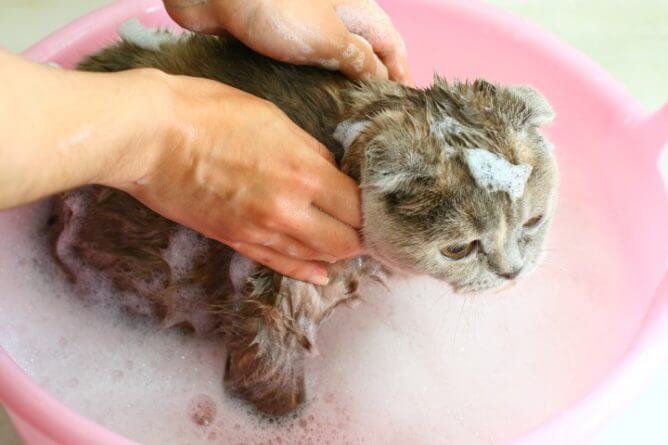
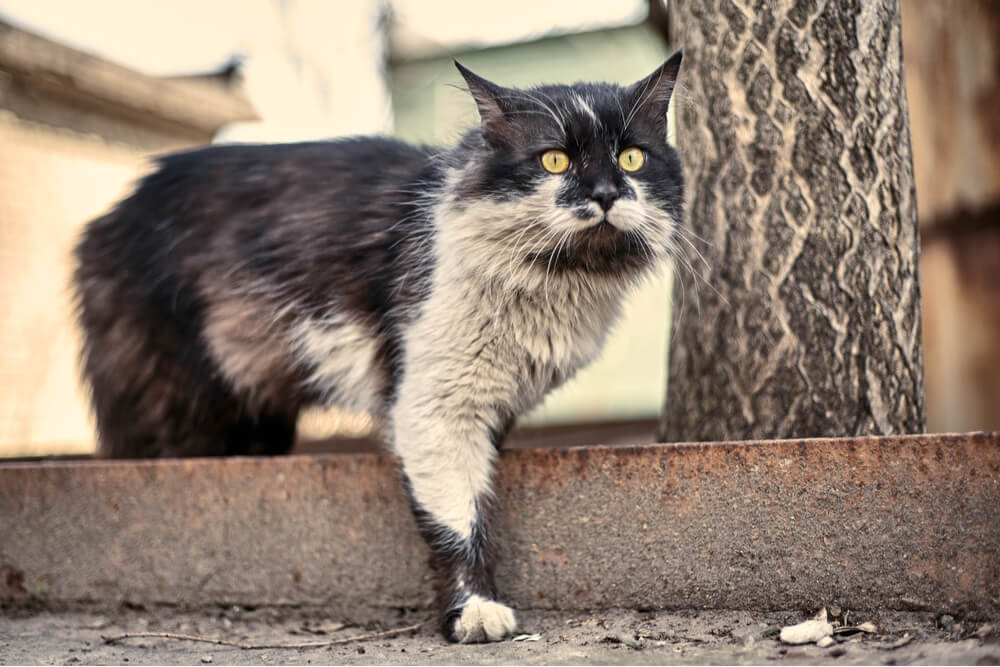
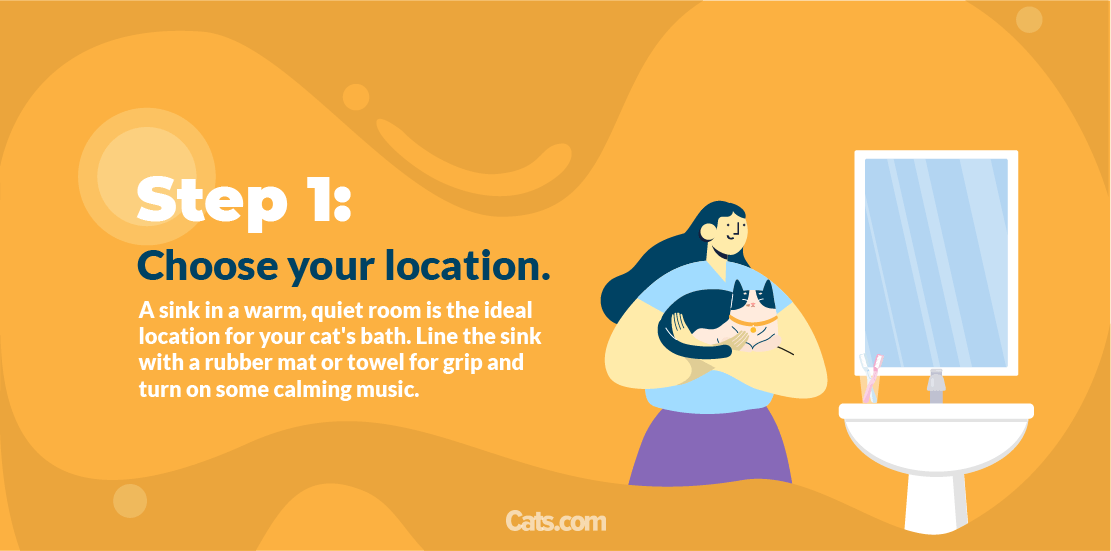
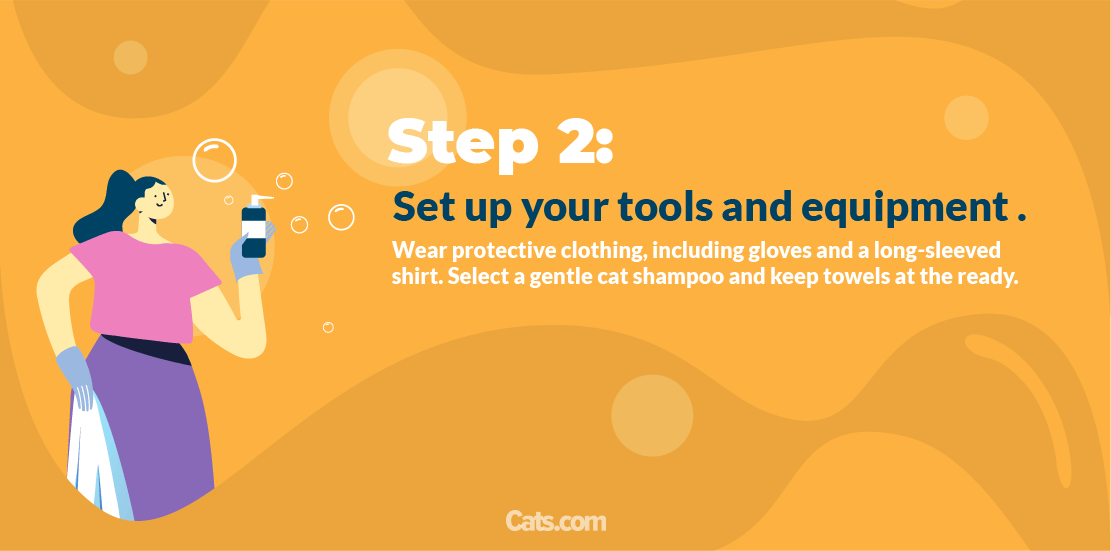
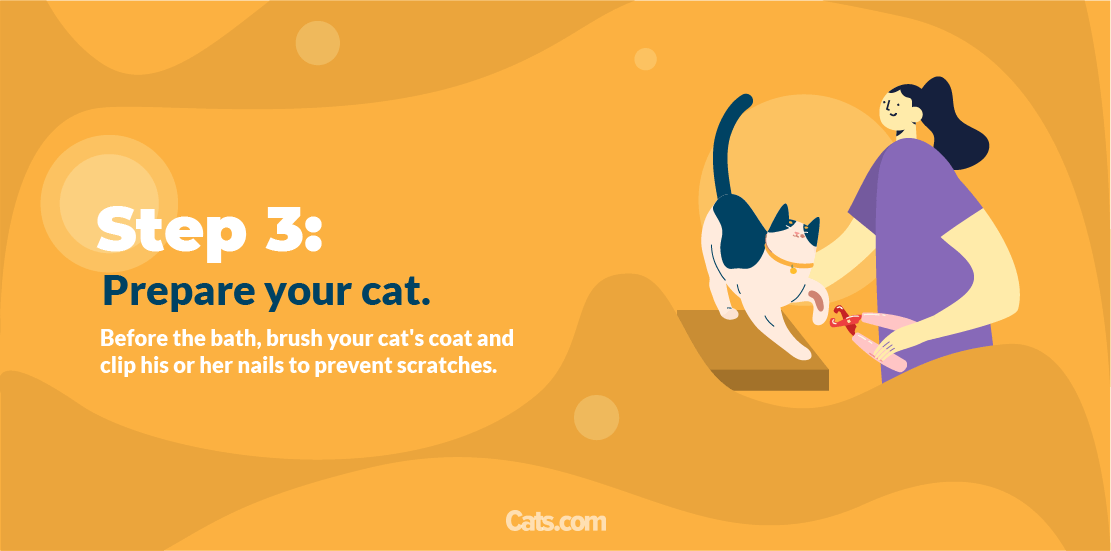
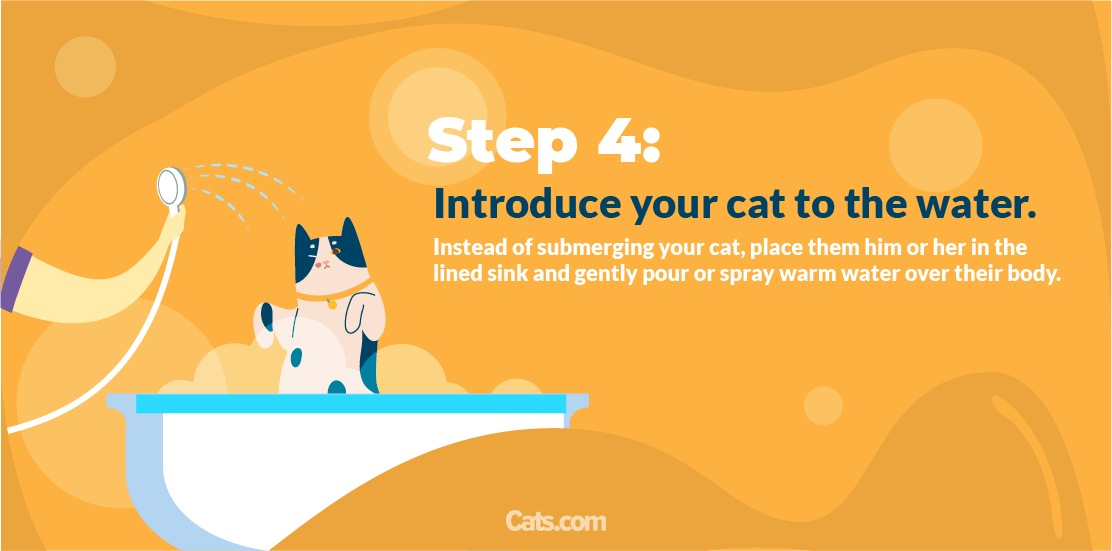
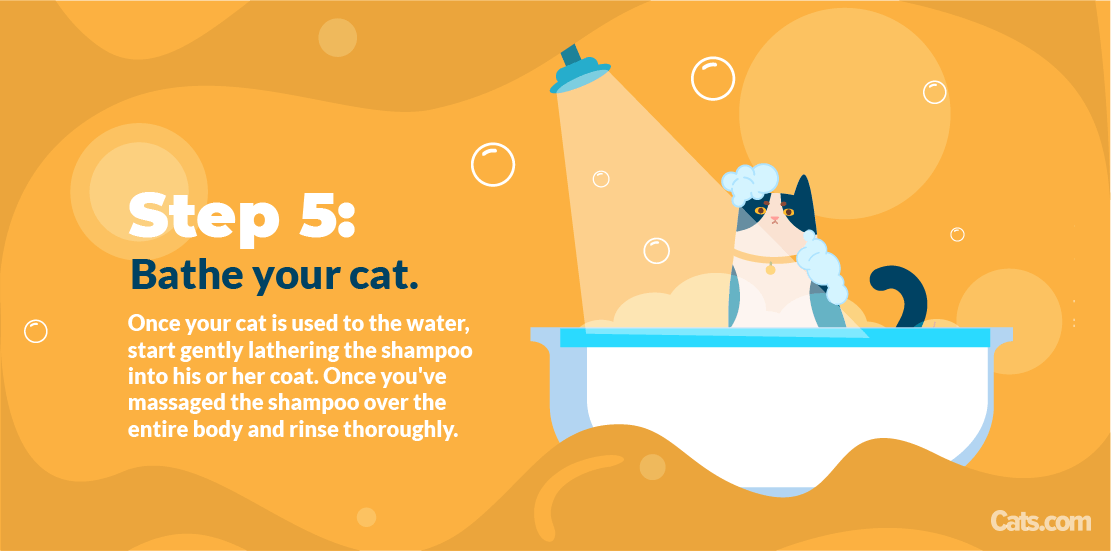
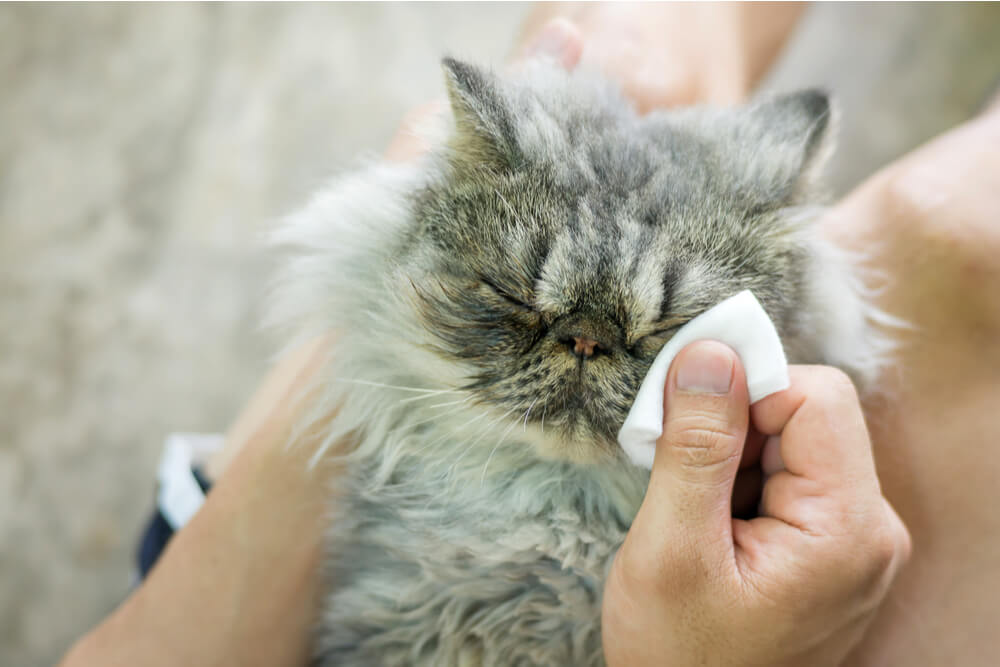
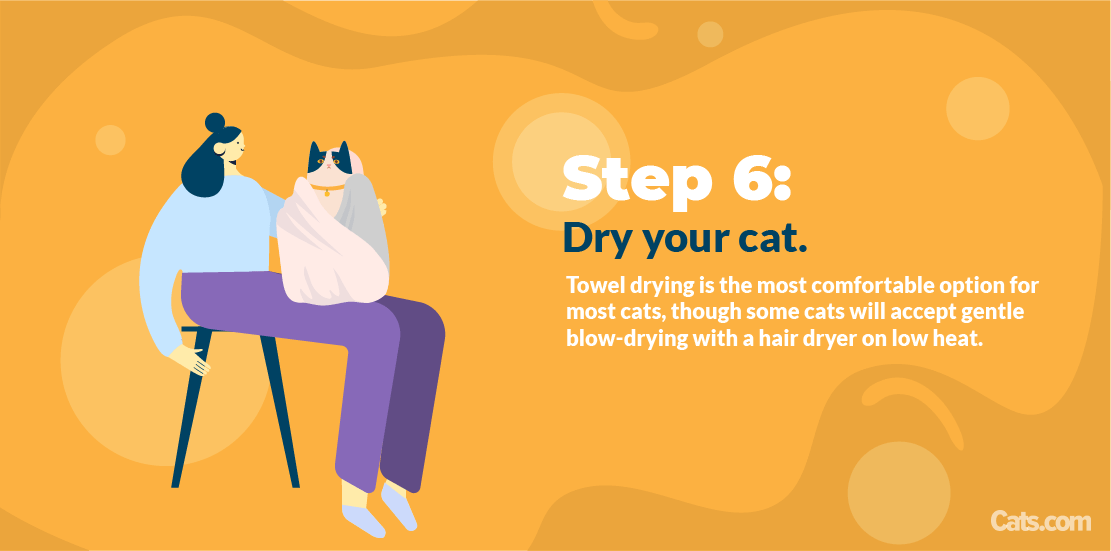
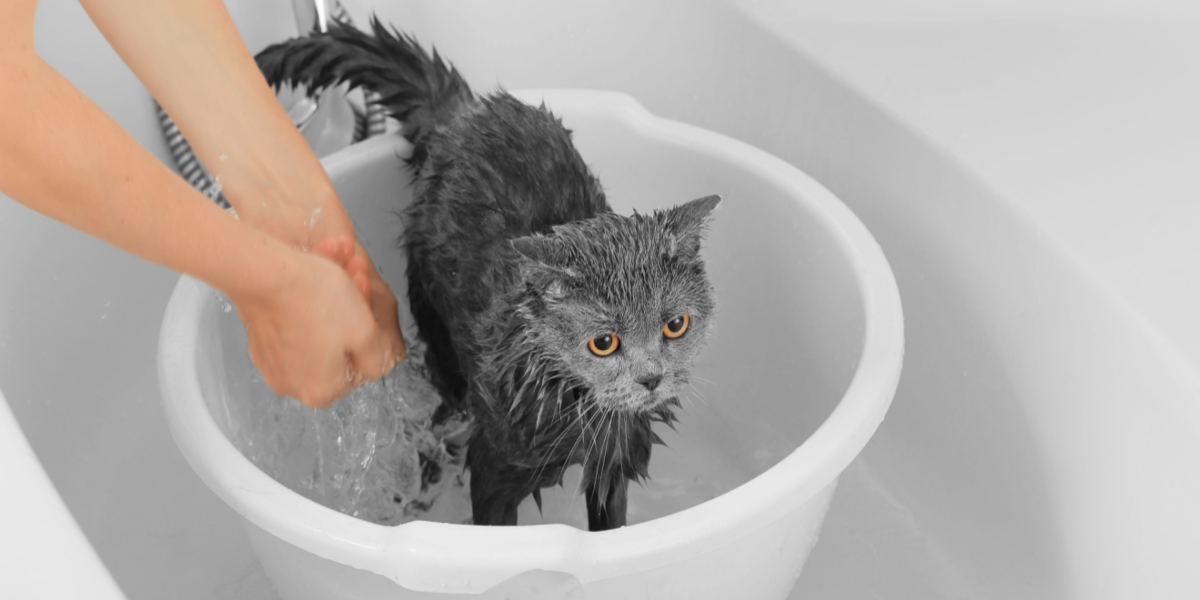



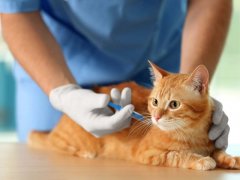

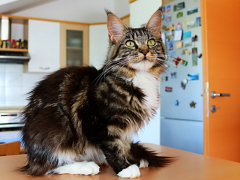
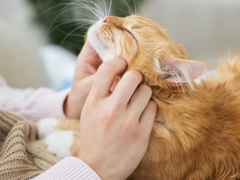
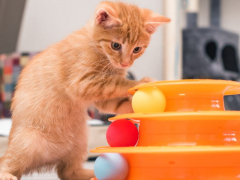
I’m glad to see that warm water was mentioned. Too often people use cold tap water and that will make your cat miserable! My cat likes to climb in the sink and play with running water. I will start the water running and when he climbs in the sink, I will close the drain. It usually takes him a couple of minutes to realize that he’s sitting in the water and by that time the bath is halfway over. (I never said that he was the smarted cat! LOL!)
My nephew-cat likes to listen to Tupac when getting bathed. Calms him down.